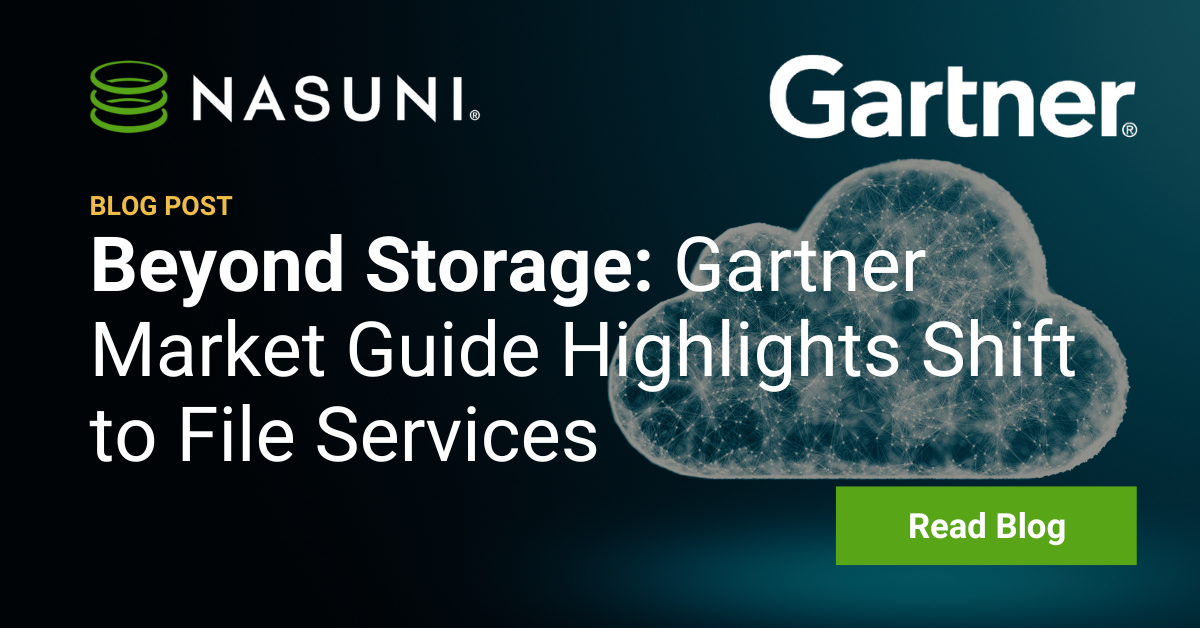Beyond Storage: Gartner Market Guide Highlights Shift to File Services
In the early days of cloud, the push to transform enterprise file infrastructure centered around storage. File data was growing rapidly and unpredictably, and the cloud offered a way to expand capacity on demand. While storage continues to be a major driver behind cloud transformations today, organizations are also looking for more. They don’t simply want cloud file data storage. They want cloud file data services. There are more boxes to check, including cyber resilience, intelligent data insights, and the ability to access data from anywhere.
December 13, 2022

In the early days of cloud, the push to transform enterprise file infrastructure centered around storage. File data was growing rapidly and unpredictably, and the cloud offered a way to expand capacity on demand. While storage continues to be a major driver behind cloud transformations today, organizations are also looking for more. They don’t simply want cloud file data storage. They want cloud file data services. There are more boxes to check, including cyber resilience, intelligent data insights, and the ability to access data from anywhere. Our success in both landing new customers and cementing Nasuni’s role as a critical piece of their infrastructure is proof of this shift. Yet we were still excited to see Gartner validate this larger market trend.
The Gartner Market Guide for Hybrid Cloud Storage explains that leading vendors are transforming from storage providers into more well-rounded platform services providers to meet the evolving needs of enterprises. Yes, capacity and disaster recovery continue to be major drivers. But IT leaders are now looking for more out of their hybrid cloud solutions.
- Resilience: The need to protect your organization and its data is more important than ever in the age of ransomware — a complete cloud file services platform needs to enable fast recoveries for the sake of the business.
- Portability: Vendor lock-in should be a thing of the past; as an organization, you should be able to retain the flexibility to switch cloud providers at some point in the future without disrupting your business.
- Data Insights: Once your file data is maintained in the cloud, you should be able to make use of cloud-based business analytics tools from various vendors.
- Anywhere Access: Gartner cites the demand for global access to data; in the last few years “global” implied any location or physical office. Now, however, IT is going to need to provide access from anywhere on the planet, including a coffee shop in a far-flung locale.
- Operational Efficiency: A more versatile file services platform shouldn’t increase management complexity — that global file data services platform should be easy to oversee and manage remotely.
This last feature is somewhat counterintuitive, yet critical. As file infrastructure shifts to the cloud, and file storage silos around the world are consolidated into a single cloud-native platform, your life in IT should get easier.
How to Choose a Platform
The Gartner Market Guide for Hybrid Cloud Storage places Nasuni in good company alongside Microsoft, Google Cloud, and AWS, but the guide doesn’t explicitly endorse one solution over another. Instead, it’s a tool designed to give IT leaders a better understanding of what’s out there so you can make the best choice for your organization.
One of the best pieces of advice is to start with a particular workload, dataset, or use case(s). Identify that critical need within your organization and begin your search for the right platform by evaluating which of Gartner’s representative vendors will best address that need. Be sure to also consider the impact of doing nothing, sometimes that’s even a more critical driver than an identified use case.
This is where most of our conversations with our customers start. Some organizations want to accelerate collaboration on building designs or video game builds. Others want to break down data silos and provide flexible capacity. Increasingly, organizations are coming to us because they understand that backup won’t really protect them against ransomware. And some companies simply want to reduce their costs. Regardless of the initial focus of our engagement, though, our customers often choose Nasuni because of how our technology checks off multiple boxes. That’s the beauty of providing a true cloud platform.
Our competitors are listed in the guide, too, but we’re confident enough in the Nasuni File Data Platform that we’re offering the report here. Consider your workloads, datasets, or use case(s). Evaluate our competition. Take note of the technical architecture behind each platform and whether it’s built to scale and evolve as your needs change.
Let us know when you want to talk.